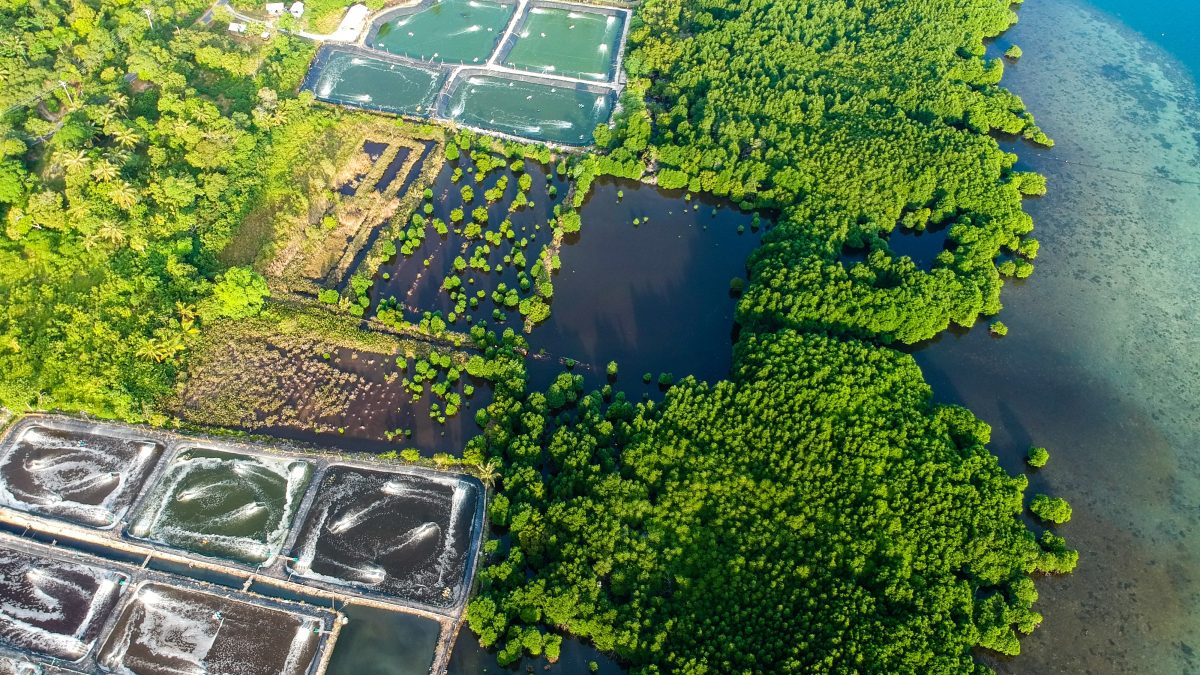Silvofisheries: Balancing Mangrove and Fisheries Harmony

Photo Credit : Sumarto Rofiun/Shutterstock
Mangroves are unique and valuable ecosystems that provide a range of ecological and socio-economic benefits to coastal communities. They support a high diversity of flora and fauna, protect the shorelines from erosion and natural disasters, filter pollutants and nutrients from the water, and store large amounts of carbon. Mangroves also serve as a source of food, income, and livelihood for millions of people who depend on fishing, aquaculture, tourism, and other activities.
However, mangroves are facing severe threats from human activities, such as deforestation, conversion, pollution, overexploitation, and climate change. According to the Global Mangrove Watch, the world has lost about 20% of its mangrove area since 1996, mainly due to the expansion of shrimp aquaculture. Shrimp aquaculture is one of the most profitable and fastest-growing sectors in the global seafood industry, but it also has negative impacts on the environment and society. Shrimp aquaculture often involves the clearing of mangrove forests, the use of chemicals and antibiotics, the discharge of wastewater and organic waste, and the introduction of exotic species and diseases. These practices not only degrade the mangrove ecosystems, but also reduce their resilience and adaptation capacity to the effects of climate change, such as sea level rise, storm surges, and salinity intrusion.
Therefore, there is an urgent need to find a balance between mangrove conservation and aquaculture development, in order to ensure the sustainability and well-being of both the ecosystems and the communities. One of the possible solutions is silvofisheries, a form of integrated mangrove-aquaculture system that combines the cultivation of mangrove trees with the rearing of fish, shrimp, or other aquatic animals. Silvofisheries aims to optimize the use of land, water, and biological resources while minimizing environmental and social costs.
Silvofisheries have been practiced in Indonesia for decades, as a traditional and low-input system of brackish water aquaculture. Indonesia has the largest mangrove area in the world, covering about 3 million hectares, and also the largest shrimp producer in Southeast Asia, with an annual production of about 600,000 tons. However, Indonesia has also experienced a significant loss of mangroves, due to the conversion of mangrove forests into intensive shrimp ponds. To address this issue, the Indonesian government has promoted the development of silvofisheries as an alternative and sustainable model of aquaculture, especially in the provinces of Riau, South Sumatra, and South Sulawesi.
There are different types and models of silvofisheries, depending on the location, design, and management of the ponds and the mangroves. Some of the common types are:
-
- Tambak Tumpangsari : This type involves the planting of mangrove trees inside the pond, along the dikes, or around the pond. The pond is usually stocked with fish, shrimp, or crabs, and the water exchange is regulated by sluice gates. The mangrove trees provide shade, shelter, and food for the aquatic animals, and also filter the water and stabilize the soil. The pond forest can increase the productivity and profitability of the pond, and also enhance the biodiversity and ecosystem services of the mangrove.
- Empang Parit : This type involves the digging of canals within the mangrove forest, where the aquatic animals are reared. The canals are connected to the sea by wooden gates, which allow the natural stocking and harvesting of the animals. The canals are usually 5-10 meters wide and 1-2 meters deep, and the water level fluctuates with the tides. The canal pond can maintain the natural structure and function of the mangrove forest, and also provide a source of income and food security for the local people.
Silvofisheries has many advantages and benefits, such as:
-
- It can increase the production and income of the aquaculture farmers, by improving the growth, survival, and quality of the aquatic animals, and by diversifying the products and markets.
- It can conserve and restore the mangrove ecosystems, by preventing further deforestation and degradation, and by enhancing the regeneration and rehabilitation of the mangrove trees.
- It can provide multiple ecosystem services, such as carbon sequestration, nutrient cycling, water purification, shoreline protection, and climate regulation.
- It can support the biodiversity and food web of the coastal and marine ecosystems, by providing habitat, refuge, and food for many species of fish, crustaceans, mollusks, birds, reptiles, mammals, and plants.
- It can improve the livelihood and well-being of the coastal communities, by creating employment opportunities, reducing poverty, increasing food security, and strengthening social capital.
However, silvofisheries also face some challenges and limitations, such as:
-
- It requires careful planning and design of the pond and the mangrove, taking into account the site conditions, the species selection, the stocking density, the water quality, and the disease prevention.
- It requires proper management and maintenance of the pond and the mangrove, involving the monitoring, harvesting, pruning, fertilizing, and replanting of the mangrove trees, and the water exchange, feeding, and health care of the aquatic animals.
- It requires strong institutional and legal support, including the clarification of the land tenure and ownership, the provision of technical and financial assistance, the enforcement of the regulations and standards, and the promotion of the best practices and innovations.
- It requires a high level of participation and collaboration among the stakeholders, including the government, the private sector, the NGOs, the research institutions, and the local communities.
Silvofisheries is a promising and viable option for balancing mangrove and fisheries harmony, but it also needs to be implemented and improved with caution and care. It is not only a matter of production or conservation but also a matter of sustainability and resilience that requires a long-term and dynamic vision.

